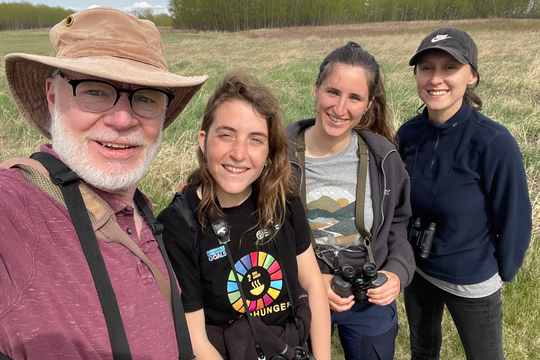Studying the Future of Working Landscapes

How agriculture and nature work in harmony in biospheres has piqued international interest.
This summer, three master's students from France are studying the relationship between agriculture and the environment in the Beaver Hills Biosphere to understand those connections and learn how we can all live more sustainably.
Louise Barbeau, Lena Collet and Lucile Pottier are agricultural engineering students at AgroParisTech and AgroSupDijon. Together, the students founded NALIA (Nature in connection with agriculture). This organization seeks to understand the complementary relationship between nature and agriculture through projects like the one Barbeau, Collet and Pottier are undertaking in Canada this summer.
The students are spending April to August of this year investigating several Canadian biospheres – Beaver Hills Biosphere and Waterton Biosphere Reserve in Alberta, and Howe Sound and Mount Arrowsmith Biosphere in British Columbia – to better understand the synergies between agriculture and nature in these unique places. Deepening their understanding of the relationship between the natural world and agricultural development and developing materials to help stakeholders understand their role in that relationship, the students hope to bring environmentally sustainable practices to farmers and land managers in Canada and France.
Through their project, the students seek to reframe the misconception that nature is a hindrance to agricultural production. Rather, nature should be viewed as a valuable ally to crops, a vital part of the ecosystem and part of a shared landscape. For example, by maintaining natural areas at the edge of farmers’ fields or shifting harvest dates so as not to disrupt nesting birds, agriculture can function in harmony with nature. Agriculture has a significant footprint and impact on the landscape, which conventional farming doesn’t take into consideration.
"Society is at a turning point," says Barbeau. "We have a lot of opportunities to change how people farm and develop the land, which is so important because that influences the future of the landscape."
Biospheres have long attracted researchers keen on understanding and enhancing the relationships between people and their environments. The Beaver Hills Biosphere was of particular interest to the students because of the diversity of land it encompasses, including wetlands, forests and other features, plus the variety of animals and plants that call the region home. The region’s natural history and diverse agricultural activity, from livestock to crops, make the Beaver Hills a great setting to study and understand how the environment and agriculture coexist. It also presents opportunities for the students to engage stakeholders, from land managers to farmers, on how they can contribute to the ongoing conservation of the natural assets within the Biosphere.
“In this context, it is interesting to see how all the elements of a biosphere function, ” added Barbeau.
Recognizing the rich Indigenous culture and knowledge associated with the Beaver Hills is also a key element of better understanding the relationship between people and their environments. Indigenous peoples have a deep knowledge of this place that can inform land use and development in the Biosphere.
When it comes to understanding how cultural practices, conservation efforts and agriculture in the area are interconnected, Elk Island National Park, located within the Biosphere, not only offers a tangible example of how people and nature interact, but also insight into how incorporating Indigenous knowledge of the land can inform conservation and sustainable farming practices.
“Indigenous knowledge is an application of the root idea of our project: a synergy between nature and agriculture,” says Barbeau. “This understanding is really relevant for our work, because it can teach us how to integrate nature into farming, showing us the richness and importance of nature.”
Indigenous traditions integrate nature in farming and rely on wild species for food and medicine. The students hope to bring this knowledge to a broader audience, that this approach can inform farmers and land managers in future development.
When it comes to understanding the connection between Western science and nature, the students are particularly interested in agronomy, a field primarily concerned with larger-scale crop production and soil management. Nature provides services to agriculture (also known as ecosystem services), and in return, integrated and sustainable agricultural management practices can support natural biodiversity. The relationship between the land and agriculture can be mutually beneficial with the right approach.
Agriculture has a significant role to play in maintaining biodiversity and farmers have a vested interest in preserving natural landscapes for the ecosystem services provided by plants and animals. Pollinators and pest predators help crops thrive. Trees offer protection from the wind and prevent soil erosion. In the long run, the natural world can make farms more effective and profitable.
As they pursue their project, connecting with people in different fields, they hope to build a more robust understanding of the links between the environment and agriculture, and build connections and synergies between stakeholders to preserve the environment and promote sustainable agriculture.
Once the project is complete, Barbeau, Collet and Pottier will share their findings with stakeholders in the Biosphere and the broader community providing suggestions for how agriculture and the environment can live more harmoniously. By preparing a comprehensive report, producing a podcast and hosting a conference, the students hope to reach a broad spectrum of people interested in sustainability.
Ultimately, they hope their project also helps the public understand more about how the environment and agriculture impact each other and how we can approach that relationship with an ethic of sustainability.
“The Biosphere has a key role to play as a meeting place between farming and nature conservation, and where people can learn about nature and how to protect it,” offers Barbeau.
Learn more about their NALIA project.